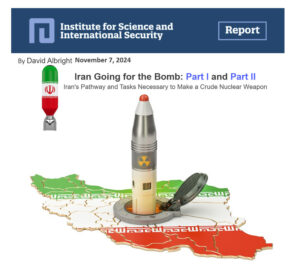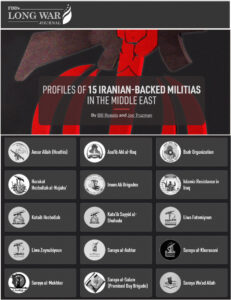 Part I report is one of two new reports that summarize those findings and add some new thinking from the Institute and knowledgeable officials on Iran’s pathways to nuclear weapons and the tasks needed to build nuclear weapons. This report, Part I, evaluates pathways and timelines to nuclear weapons. Part II summarizes the tasks needed to construct a nuclear weapon, both to produce sufficient weapon-grade uranium (WGU) and to build the nuclear weapon itself.
Part I report is one of two new reports that summarize those findings and add some new thinking from the Institute and knowledgeable officials on Iran’s pathways to nuclear weapons and the tasks needed to build nuclear weapons. This report, Part I, evaluates pathways and timelines to nuclear weapons. Part II summarizes the tasks needed to construct a nuclear weapon, both to produce sufficient weapon-grade uranium (WGU) and to build the nuclear weapon itself.
The two-part report series discusses these issues. This report, Part II of the series, evaluates the tasks necessary to build a nuclear weapon, in particular a crude one, and adds some new thinking on those tasks. Part I discusses Iran’s pathways to nuclear weapons.
As of September 2024, it could produce enough weapon-grade uranium for a nuclear weapon in seven days and have enough for six to nine nuclear weapons in a month, where the range depends on whether Iran uses only the deeply buried Fordow enrichment plant or both the Fordow and Natanz enrichment plants, respectively. 4 After more than twenty years of effort, Iran has mastered the process of making weapon-grade uranium and of doing so quickly. That effort to develop the means to make weapon-grade uranium was started in the Al Ghadir project of the Amad Plan in the early 2000s, the project which launched the underground enrichment facility which we now know as the Fordow enrichment plant.
Going for the Bomb: Part I, Pathways and Timelines
Going for the Bomb: Part II, Tasks to Make a Crude Nuclear Weapon
THERE IS NO CIVILIAN USE FOR URANIUM ENRICHED ABOVE 20 PERCENT. A COMMON FALLACY IS THAT IRAN WOULD REQUIRE HIGHLY URANIUM-ENRICHED URANIUM OF 90 PERCENT (HEU) TO MAKE A NUCLEAR WEAPON, AND URANIUM ENRICHED TO 60 PERCENT IS SIGNIFICANT ENOUGH TO MAKE A BOMB.
As of May 27, 2024, Iran has 142.1 kilograms (313.2 pounds) of uranium enriched to 60 percent. This is an increase of 20.6 kilograms (45.4 pounds) since the last report from the International Atomic Energy Agency (IAEA) in February. “And may have more. “
About 40-42 kilograms (kg) of 60 percent enriched uranium (uranium mass). With this quantity, an enrichment level of 60 percent suffices to create a relatively compact nuclear explosive; further enrichment to 80 or 90 percent is unnecessary. According to the International Atomic Energy Agency (IAEA),
MINIATURIZING NUCLEAR WARHEADS & NUCLEAR TRIGGER – The most critical aspect of Tehran’s capability of not only producing nuclear weapons but also miniaturizing nuclear warheads to fit into a variety of Tehran’s inventory of missiles and a nuclear weapons trigger mechanism. Enter Soviet’s Nuclear Weapons Expert Professor Danilenko Vyacheslav. Yet, strangely, we hear little about him.
Professor Danilenko Vyacheslav International Atomic Energy Agency (IAEA) 2011 Iran Safeguards Report: Iran’s Work and Foreign Assistance on a Multipoint Initiation System for a Nuclear Weapon.
Most of that evidence surrounds Professor Vyacheslav Danilenko, a high explosives expert from the Cold War era. The IAEA confirmed that he was in Iran from 1996-2002 and returned to Russia. The IAEA verified through three separate sources, including the expert himself, that he was in the Islamic Republic then. Reuters reported that from the 1950s until his retirement, Danilenko worked at the All-Russian Scientific Research Institute of Technical Physics (VNIITF), which is a top-secret Soviet nuclear weapons complex research center in the Ural Mountains. Yet it is strange he persists in claiming, “I am not a nuclear physicist.”
The IAEA obtained additional information that adds credibility to the conclusion that Danilenko used his technical and practical knowledge and expertise to provide assistance to Iran’s program to develop a suitable initiation system for a nuclear explosive device. The IAEA assessed that a monitoring, or diagnostic, technique described in one of his papers had a remarkable similarity to one that the IAEA saw in material from a member state about a hemispherical initiation and explosives system developed in Iran (see below). This system is also described in the IAEA safeguards report as a multipoint initiation system used to start the detonation of a nuclear explosive. The system that the IAEA says Iran was developing prior to 2004 was relatively sophisticated and small in diameter. Iran is unlikely to have been able to design it on its own. According to the November 2011 IAEA safeguards report, Iran is also believed to have obtained information from the A.Q. Khan network on nuclear weapons design. But the initiation and explosive system is sufficiently sophisticated that it points to a contribution from Danilenko.




